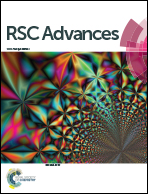Effect of grafting density of the side chain on the microstructure and properties of proton exchange membranes based on polyvinyl alcohol and poly(ionic liquid)
Abstract
The relationship between the grafting density of the hydrophobic side chain and the microstructure of proton exchange membranes (PEMs) has been investigated thoroughly. Compared with the poly(ionic liquid)/polyvinyl alcohol/caprylic acid-0 (PIL/PVA/CA-0) membrane, when the hydrophobic side chains are grafted onto PVA, the SAXS results show that the PIL/PVA/CA-m (m = 0.05, 0.1, 0.15) membrane can generate ionic clusters which is of benefit to proton conduction. Meanwhile, the PIL/PVA/CA-0.05 membrane shows a higher proton conductivity at the same temperature compared with other membranes; this is attributed to the aggregation of bigger ionic clusters which can facilitate the formation of interconnected broad ionic channels. The highest proton conductivity of the PIL/PVA/CA-0.05 membrane is 158 mS cm−1; it is higher than that of Nafion117 (129 mS cm−1 at 80 °C). Moreover, the high grafting density would reduce the tolerance of the PEM to the attack of OH˙, but lower water uptake is of benefit for improving the oxidative stability, this is induced by the entanglement of side chains under higher grafting density. We anticipate that this finding will shed new light on the design of polymer structures of PEMs and relevant electrochemical devices.


 Please wait while we load your content...
Please wait while we load your content...